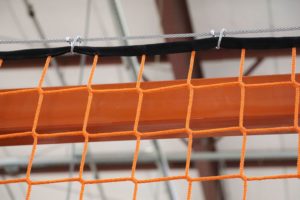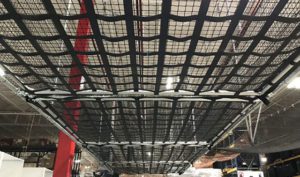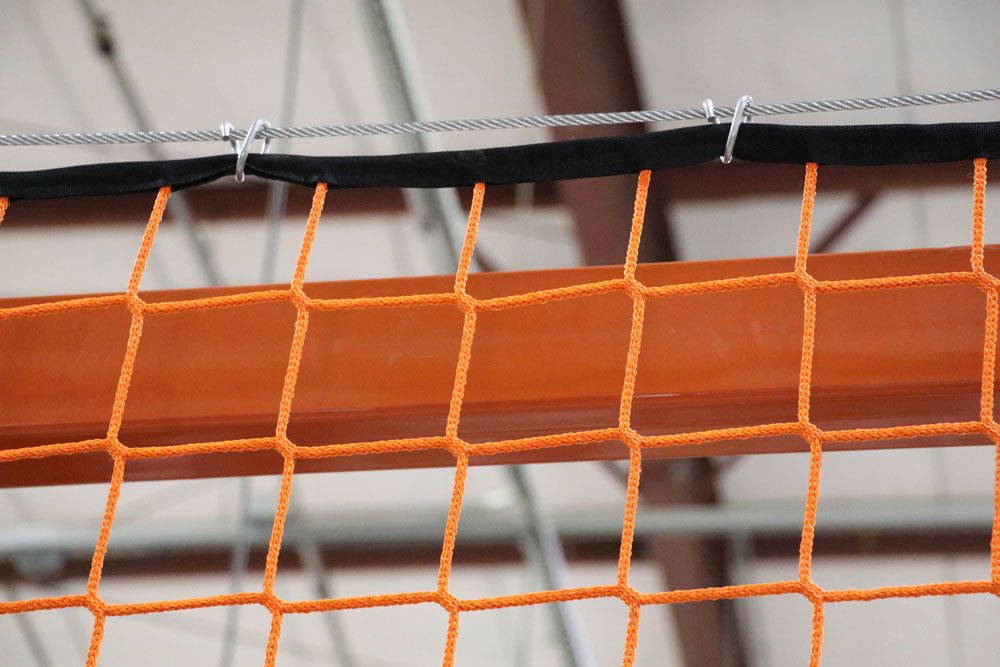December 2020
Part 2 of an Informational Series
From InCord Safety Netting Solutions
3 Common Safety Netting Specification Mistakes to Avoid
1. Mesh Size
 This one seems fairly straightforward, right? Just make sure that the mesh size will contain whatever it may catch. For instance, you wouldn’t want 4” square mesh to catch a soup can. But you need to think beyond that, particularly if you are storing packaging with small items, granular or liquids. You cannot assume that the packaging will remain intact when it is caught. In these cases, a solid or a fine mesh liner can easily be incorporated into the design.
This one seems fairly straightforward, right? Just make sure that the mesh size will contain whatever it may catch. For instance, you wouldn’t want 4” square mesh to catch a soup can. But you need to think beyond that, particularly if you are storing packaging with small items, granular or liquids. You cannot assume that the packaging will remain intact when it is caught. In these cases, a solid or a fine mesh liner can easily be incorporated into the design.
2. Netting Capacity
 This one also seems like a bit of a “no-brainer”. The netting capacity should be strong enough to hold the potential load. The most common error we see for pallet rack applications is that people tend to think about the individual boxes, rather than the whole pallet. Make sure your netting can sustain the weight of one pallet. While the likelihood of one crashing down may be low, it happens. We have seen it. It is ugly – and you will wish you were better prepared.
This one also seems like a bit of a “no-brainer”. The netting capacity should be strong enough to hold the potential load. The most common error we see for pallet rack applications is that people tend to think about the individual boxes, rather than the whole pallet. Make sure your netting can sustain the weight of one pallet. While the likelihood of one crashing down may be low, it happens. We have seen it. It is ugly – and you will wish you were better prepared.
3. Deflection
 Remember watching trapeze artists at the circus or on TV? After the final act, they dismount and get caught by the safety net. The net deflects downwards, and your heart might skip a beat as the performers drop further down toward the floor. But they never do – thanks to smart engineering. Deflection must be considered carefully for certain applications, such as conveyor system protection. Make sure that the material and the system configuration allows for minimum or acceptable deflection without hitting anyone, or the floor.
Remember watching trapeze artists at the circus or on TV? After the final act, they dismount and get caught by the safety net. The net deflects downwards, and your heart might skip a beat as the performers drop further down toward the floor. But they never do – thanks to smart engineering. Deflection must be considered carefully for certain applications, such as conveyor system protection. Make sure that the material and the system configuration allows for minimum or acceptable deflection without hitting anyone, or the floor.
When specifying the right netting for your specific need, be sure to think beyond the day to day. Work with a distributor or systems integrator that is experienced with your particular application, ask questions & benefit from their expertise. The purpose of a well-designed safety netting system is to perform as expected when put to the challenge, big or small. Make sure you are prepared for a possible worst-case scenario – no matter how unlikely it may seem.
To learn about InCord’s Industrial Safety Netting Solutions – Click here. Our OSHA compliant netting solutions are custom fitted to your facility and optimized for your application. From full pallet protection to spill containment, all you need is InCord.
InCord’s Safety Netting Solutions
860.537.1414 or email netting@incord.com
Keep an eye for our next blog, as we continue to discuss material handling safety tips.
A leader today and tomorrow.
In 2020, InCord was recognized by its employees and was awarded the Top Workplace by the Hartford Courant for the tenth consecutive year.
InCord provides custom netting solutions for Material Handling, Construction, Amusement, Sports, Theatre, Service Pits (BayNets™), Specialty, and Environmental/Ecological Restoration markets. InCord’s custom solutions meet or exceed applicable safety standards due to consistent research, testing and direct involvement with renowned safety organizations, such as ANSI, OSHA, and ASTM. InCord also offers in-house design, installation and extraordinary customer service for a complete, turn-key experience. Green Bureau Certified Platinum




